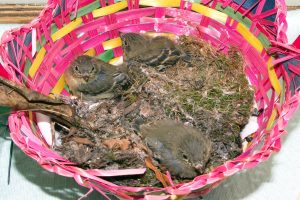Support Us
Since 1979 more than 140,000 animals have been treated by Wildlife Rescue.
Thanks to the support of individuals like you, Wildlife Rescue can provide a lifeline for animals in distress.
Pacific-slope Flycatchers
Pacific-slope Flycatchers are an attractive, small-sized bird that breed in forests and mountains along the West Coast. These small birds have olive-colored heads as well as yellow and brown breasts which help them blend into forests and other woodlands to hide from predators.
The diet of a Pacific-slope Flycatcher includes insects such as flies, beetles, moths and spiders which they either catch while flying or by foraging in shrubs. They will also eat berries including blackberries and elderberries. Female flycatchers build nests in trees and large shrubs to stay close to their rich food supply. They weave together moss, strips of bark, and leaves on the exterior of the nest using spiderwebs and squeeze their nests into tight spaces such as tree crevices – making their nests harder to spot by predators.
Recently, three baby flycatchers were brought to Wildlife Rescue after an onlooker noticed the fallen nest and no parents nearby. These orphaned nestlings were severely dehydrated and required immediate care. Pacific-slope Flycatchers nest with their parents for 14-15 days and are incapable of self-feeding.

Wildlife Rescue hospital staff worked hard around the clock feeding the young babies every 15 minutes from dawn to dusk to help them survive. Thankfully, these incredible birds have recovered from their initial dehydration and are now learning to recognize natural food and slowly self-feed. They will be cared for until they are old and strong enough to be released back into the wild and survive on their own.
Challenges They Face
Thankfully, the young fledglings in our care are slowly gaining weight and learning how to flap and perch – but there are still many challenges they will face.
Loss of habitat is one problem these birds face. While flycatchers can create nests in artificial structures such as buildings, they also rely on trees for places to catch and eat bugs and create nests – so when a tree is lost, they lose both food and a nesting spot. As well, chopping down healthy trees makes soil unstable – leading to more trees potentially falling. The usage of pesticides is also harmful to these birds – not only does it eliminate their food source, but it can make them ill as well.
How Can We Help?
Fortunately, there are many ways to help Pacific-slope Flycatchers, such as…
What if I Find a Nest?
Of course, accidents are accidents – and even though we try our best, nests fall. If you see an egg or young nestling that has fallen from their nest, gently placing them back in the nest they fell out of is a great way to help them out. The fact that you touched the egg/nestling will not harm it, nor will the parents reject it – that is just a myth!
However, if you see a nest with eggs or nestlings that have fallen, first make sure the nest fell – many birds nest in the ground (including California Quail and Killdeer). Are they in a hole that could have been dug by their mother? Are they hidden and protected? If you answered yes, then it is likely they are simply ground-nesting birds. If you’re sure that the nest fell and the eggs or nestlings are in need of help, give the mother a chance to find her nestlings by leaving the eggs and birds in a small container (such as a margarine container with holes in the bottom) with as much nesting materials you can recover and hanging your “nest” from the tree from which they fell.
Does it look like the mother is coming back? It might take some time so watch carefully for 1-2 hours. If not, there are a few things you need to do. Create a fake nest using a box (such as a shoebox) and line it with something soft, warm, and insulating – small blankets are great options. Place the birds in the box and keep the box covered, away from pets and people and keep it warm. Then, reach out to Wildlife Rescue’s Support Centre at 604-526-7275 – we will make sure these nestlings get the care they need.
What About Injured Birds?
Of course, we can all do our part to help injured birds. If you see a bird that has exposed bone or blood, bugs or insects covering it, no feathers, or a bird that is sleeping, human intervention is required. Call Wildlife Rescue’s Support Centre at 604-526-7275. To help us return your call quickly, please leave your contact information and observation. We will make sure the bird is treated with kindness and compassion.
Making simple changes such as adding decals to our windows, leaving trees alone, planting native plants, and rescuing birds in need are great ways to support this beautiful species. Donating to Wildlife Rescue is another easy way to help – we provide rehabilitation to 5,000 animals a year with unique care for every one of them. Learn more about donating here.